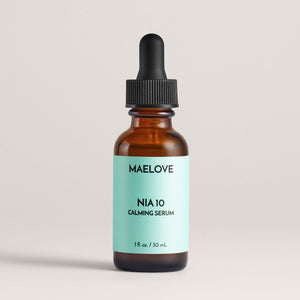Today we address the question, do I need to worry about the stability of Niacinamide in my serum?
Now the good news is that Niacinamide is one of the most stable vitamins in use.
The main thing to look for with Niacinamide in a serum is the pH of the formulation. The pH range should be between 4 to 6. And the reason is that outside this pH range, niacinamide can much more easily become niacin, which is irritating to the skin.
Niacinamide is great for the skin and you’ll find it used in a huge variety of skincare products. Niacinamide helps promote a stronger and more supple skin barrier that combats skin dryness and is a powerful anti-inflammatory that can calm red and inflamed skin.
It can increase collagen production, fight hyperpigmentation, and regulate sebum production to help manage acne. It’s one of the very best, one of the most researched and proven ingredients out there.
If you want to learn more about niacinamide, check the link below for our in-depth paper on how niacinamide works.
Click here for Maelove's Deep Guide to Niacinamide
Another huge advantage of niacinamide is that it’s usually well tolerated even by those of us with very sensitive skin.
Now, if you’ve experienced irritation from a niacinamide product in the past, it might be that you used a product that was not well formulated. And that led to niacinamide becoming niacin, and niacin is a known skin irritant that causes skin flushing. This skin reddening is often accompanied by an itching and burning sensation, and can be a response to topical niacin or large doses of oral niacin. Interesting fact: Those with schizophrenia are often missing this niacin flush response (Messamore et al. 2003).
Those of you who are more science savvy might say, but wait, isn’t Niacin also a form of Vitamin B3? You are correct. If you take it orally, both Niacin and Niacinamide are forms of Vitamin B3 that your body can use.
However, as a topical, Niacin doesn’t cross the stratum corneum while Niacinamide does. And more importantly, as we mentioned, though Niacinamide is well tolerated by even those with the most sensitive skin, Niacin is a known skin irritant that causes skin flushing in most people. So when it comes to topicals, Niacin is the evil cousin of Niacinamide that you want to avoid.
When you put niacinamide in a skincare product whose pH is not properly calibrated, you’re much more likely to end up with unwanted niacin.
How do we know this?
Here is a study from Finholt and Higuchi entitled “Rate studies on the hydrolysis of niacinamide”

Source: Finholt P, Higuchi T (1962)
BTW, hydrolysis basically means breaking down. For example, if you buy collagen, if it says “hydrolyzed collagen” that means it’s broken up collagen. Niacinamide hydrolyses into Niacin.
If you look at the chart here from the research by Finholt and Higuchi, the lowest point of the rate of niacinamide hydrolysis is between the pH range of 4 to 6. Seems like 5 to 5.5 being the sweet spot, which is where we formulated our Nia 10 calming serum, which is a concentrated niacinamide serum.
So, if you’re looking for a niacinamide product look for products that are properly formulated in the range of 4 to 6 in pH.
Check out Maelove NIA 10 Niacinamide Calming Serum here
Feldmann RJ and Maibach HI (1970). “Absorption of Some Organic Compounds Through the Skin in Man.” J Invest Dermatol 54(5): 399-404.
Finholt P, Higuchi T (1962). “Rate Studies on the Hydrolysis of Niacinamide.” J Pharm Sci 51(7):655-661.
Franz TJ (1975). “Percutaneous Absorption on the Relevance of In Vitro Data.” J Invest Dermatol 64(3): 190-195.
Messamore E, Hoffman WF, Janowsky A (2003). “The niacin skin flush abnormality in schizophrenia: a quantitative dose-response study.” Schizophr Res 62(3): 251-258.





